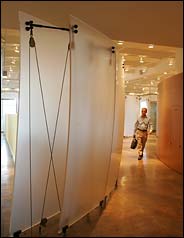
 
A Wall to Enlighten, Not Obstruct
When Robert Marc first toured the raw
space in Manhattan's trendy meatpacking district that he was considering for
an office, he certainly didn't need sunglasses. The 6,000 square feet in the
artsy Milk Studios building resembled an industrial cave.
Mr. Marc, the president and chief
creative officer of the designer eyewear company Robert Marc, found its
13-foot ceilings, exposed ductwork and concrete floors desirably gritty, but
six windows, out of a paltry eight, were clumped along the short end of an
awkward L-shaped layout, essentially depriving a third of the space of
natural light.
Yet Mr. Marc saw that the orphaned
section would suit a warehouse and customer service area, which could
function as well or better under controlled lighting. The rest of the space
could be freed for the administrative and executive functions of the
company, which creates, distributes and also sells eyewear.
But it wouldn't be easy. He would have to
maximize the scanty natural light and organize mundane business functions in
a space that could double as a stylish and provocative showroom, and
accommodate a visiting sales force, all on a lean budget of $100 a square
foot.
Accustomed to working out details in the
aftermath of inspiration, Mr. Marc signed the lease in March 2004 and hired
Michael Haverland, an assistant professor of architecture at Yale whose
residential work Mr. Marc had admired in East Hampton for its innovative
form, texture and function.
Mr. Haverland, who had never designed an
office, worked toward balancing the needs of the company's distribution and
retail businesses. In the company's Madison Avenue location, those business
functions were haphazardly strung together in 3,500 square feet of space,
and suffered from low ceilings and being spread out on three floors.
In the new quarters, Mr. Haverland said,
"it was about dividing a layout in a way that allowed each company to
be separate where they wanted to be separate, and adjacent where they wanted
to be adjacent."
By the time the 25 on-site employees
moved in last November, three zones had emerged: warehouse and customer
service in the rear third of the space; administrative areas in the middle;
and an executive wing nearest the six-windowed southern wall.
The thoughtfully designed but basic
single-room warehouse, with its rows of metal utility shelves loaded with
color-coded storage bins, requires a key code to enter, as does the customer
service room it opens onto. But security concerns bow to aesthetic ones in
the headquarters' administrative midsection.
There, a minimalist glass-and-chrome
window system laid out in an L-shape fronts the handful of single offices
reserved for employees like accountants whose jobs demand discretion. A
smaller L-shaped area of white chest-high walls, less costly than office
partitions, rise like austere hedgerows from caramel-tinted concrete floors,
partly shielding the desks of workers who need some privacy while allowing
for easy collaboration.
Inexpensive glass pendant lights drop
from a ceiling defined by a third L-shape of meticulously arrayed ductwork
with a galvanized steel finish that coordinates with the chrome and
stainless steel accents below.
Upbeat lounge music, piped through a
sound system, aurally reinforces the casual yet precise, commercial yet
sensual vibe, in which Mr. Marc's genial black terriers, Killer and Louy,
follow a lazy social circuit or gnaw on toys that include a stuffed
"Chewy Vuitton" handbag.
Dividing the administrative zone from the
executive wing and conference room is a long undulating "lens
wall" akin to an art installation. Spare despite its complex
engineering, it is a double series of plexiglass panels stretched by pulleys
and tension cables into convex and concave shapes. The "lenses"
reflect and refract light into the administrative area, and funnel visitors
from a dark reception area toward the light-endowed executive wing.
As the focal point, the wall both
symbolizes Mr. Marc's business and inspires it. Like his eyewear, Mr. Marc
said, the wall "has to be balanced and fit right and function."
"It speaks to my business and what I
do, but it also quite honestly elevates me, and I hope it elevates my staff,
to think about design."
Across the way, a freestanding wall, made
of inexpensive particle board and finished in warm amber, curves gracefully
to the right. Six desktops unfold Murphy-bed style, ideal for showing
glasses to vendors but also laptop-ready with Ethernet and electric outlets
for the traveling sales force.
Doors sunk into the curved expanse lead
to a tech-savvy conference room furnished with a vintage Florence Knoll
conference table and Charles Pollack chairs reupholstered in white leather.
With all four doors opened, the music
notched up and the lights edged down (dimmers enable fingertip transition
from computer-friendly dusk to showroom starkness to moody nighttime glow),
the space is cocktail-party ready.
"I think the office has an identity
now," said Mr. Marc, wearing a cotton-candy-pink polo shirt whose
cartoon graffiti telegraphed its status as a cult fashion item. "We're
creating unique and special designs that make people feel really good. It's
very important that we're always reminded of that, and our environment
helps." - NEW
YORK TIMES

|